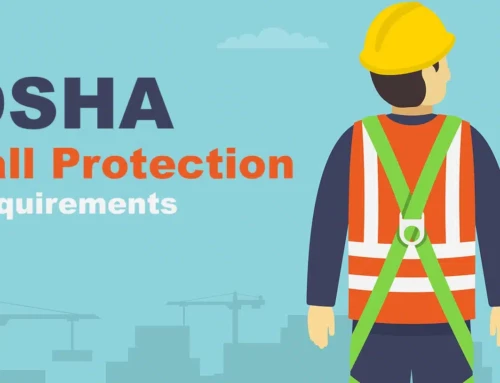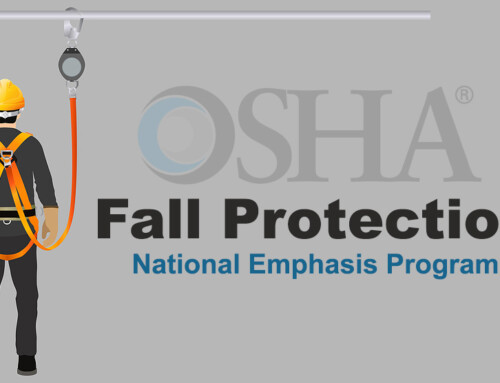Top 10 OSHA Violations for 2022: Keeping Your Company Off the List.
Every fall, OSHA announces the ten most commonly cited standards for the fiscal year. There have been slight differences in the order of the standards cited this year compared to the last several years, but little else has changed.
Let’s look at the top 10 OSHA violations for 2022.
1. Fall Protection (General): 1926.501
Fall protection is the most common OSHA violation in the US for the twelfth year in a row, encompassing nearly 50% of all citations. There has been a slight decrease in violations in 2022 compared to 2021, with 5,260 in 2022 compared to 2021’s 5,295.
Unfortunately, failure to provide proper fall protection and training comes with some of the highest on-the-job risks. Falls are the leading cause of death for construction workers.
Fall protection generally encompasses several other violations that also place on the list of the top 10 violations, including fall protection training, scaffolding, ladder usage, and fall protection training.
2. Hazard Communication Standard: 190.1200
Hazard Communication Standard (HCS) violations have been on the rise in 2022, seeing a 20% increase since 2021 and rising from the fifth most common violation to the second. 2022 saw 2,424 violations issued, compared to 2021’s 1,947.
Often, these violations are due to failure to meet the complex standards and paperwork or to gaps in training. Most commonly, these violations are due to improper labeling practices on chemical containers, not listing substances on chemical inventory lists, failing to obtain the Safety Data Sheets from manufacturers, failing to maintain a hazard communication plan, and failing to note crucial information in a written hazard communication plan.
3. Respiratory Protection: 1910.134
In 2021, respiratory protection standards ranked the second most common of all OSHA violations, but 2022 brought 300 fewer than 2021, landing it in the number 3 rank. In 2022, 2,185 violations were issued, compared to 2021’s 2,527.
OSHA dictates that proper respiratory protection must be used to protect workers. The necessary protection varies based on the work environment. OSHA requires exposure assessments to be conducted to identify the type and amount of hazardous exposure while also considering factors influencing respirator selection, such as worker characteristics and job sites. It also requires employers to understand assigned protection factors and be informed of respirators and their characteristics to determine the correct one to use.
4. Ladders: 1926.1053
Ladder violations are the number one violation in the construction industry in 2022, with 2,143 violations issued. In contrast, 2,026 were issued in 2021.
Per OSHA’s standards, ladders must not be overloaded, must be free from hazards like grease or anything else that makes them slippery, and defective portable ladders must be labeled and taken out of service. Usage standards are also provided for employees, including dictating that while climbing, workers must be facing the ladder and always have at least one hand on it. Further standards outlining the usage of different types of ladders exist as well.
5. Scaffolding: 1926.451
Scaffolding standards protect workers, but 2022 still saw an additional 110 violations compared to the previous year, with 2,058 issued compared to 1,948 in 2021.
The standard dictates that scaffolds and components must be able to support their weight plus four times the maximum intended load, be at least 18 inches wide, and have a guardrail or personal fall arrest system.
6. Control of Hazardous Energy: 1910.147
2022 brought 300 additional violations compared to 2021, with 1,977 recorded compared to 2021’s 1,698.
Controlling hazardous energy is essential to protect employees servicing equipment or machines. A machine activating while someone is servicing it could result in serious injury or death; OSHA’s standard on controlling hazardous energy provides several key requirements to protect employees. The primary two include an energy control program and lockout/tagout.
7. Powered Industrial Trucks: 1910.178
In 2022, powered industrial truck violations rose from rank 9 to 7, with 1,749 violations recorded.
Powered industrial trucks, commonly known as forklifts, are heavily used by an estimated 1.5 million forklift operators in the U.S. alone. Due to the dangers these machines can pose when not used properly, OSHA has several regulations for workers to follow, primarily on training and risk mitigation practices.
8. Fall Protection (Training): 1926.503
Fall protection training violations are down in 2022 compared to 2021, with 110 fewer in 2022. However, there were still 1,556 violations issued for failing to meet OSHA’s standard on fall protection training.
According to OSHA standards, employers must educate workers through a training program that includes hazard identification, how to mitigate hazards, fall protection and fall arrest systems, and other fall-related information. Employers must also have written documentation to verify employees have completed this training.
9. Personal Protective Equipment: 1926.102
2022 saw a similar number of personal protective equipment violations as 2021, with 1,401 issued in 2022.
Despite the number of violations not changing, this violation fell one rank from 2021, from the eighth most common to the ninth. Workers must use protection when working with or exposed to hazards such as chemicals, liquids, gasses or vapors, light radiation, flying particles, and other harmful materials. Likewise, workers working in areas with potential flying objects must also wear eye protection with covered sides.
10. Machine Guarding: 1910.212
Machine guarding violations are the tenth most common OSHA violation for the second year in a row, with an increase in violations reported in 2022 compared to 2021. 2022 brought 1,370 machine guarding violations, up from the previous year’s 1,113 by over 200.
Machine guarding is supposed to protect workers from machine hazards. OSHA provides standards for machinery and machine guarding to protect workers based on the type of machine guarding implemented.
Why Invest in OSHA Safety Training?
With the correct OSHA-compliant safety training, both at the beginning of a new employee’s time at a company and periodically during their tenure, many of the aforementioned violations can be mitigated or completely avoided. This results in safer employees and boosted morale as individuals recognize that they are more than just a proverbial cog in the machine. Not only that but ensuring proper safety training has helped many employers stay off the list of top 10 OSHA violations for 2022.
Providing safety training is a direct message to employees that they and their safety matter to the company while simultaneously reducing the number of on-site accidents. This also affects profits, as worker’s comp claims, insurance deductibles, and lower attorney fees are also reduced when the injury rate decreases. These safety training classes may be an up-front investment, but the reduction in productivity and injury make up for it.
These days, many safety training classes can be taken virtually, allowing employees to complete their training without worrying about traveling to another location or fitting it into their schedules. Because of its flexibility, online safety training is quickly becoming the preferred choice for employee safety training.



